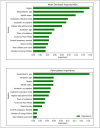Machine learning prediction of nutritional status among pregnant women in Bangladesh: Evidence from Bangladesh demographic and health survey 2017-18
- PMID: 38820295
- PMCID: PMC11142495
- DOI: 10.1371/journal.pone.0304389
Machine learning prediction of nutritional status among pregnant women in Bangladesh: Evidence from Bangladesh demographic and health survey 2017-18
Abstract
Aim: Malnutrition in pregnant women significantly affects both mother and child health. This research aims to identify the best machine learning (ML) techniques for predicting the nutritional status of pregnant women in Bangladesh and detect the most essential features based on the best-performed algorithm.
Methods: This study used retrospective cross-sectional data from the Bangladeshi Demographic and Health Survey 2017-18. Different feature transformations and machine learning classifiers were applied to find the best transformation and classification model.
Results: This investigation found that robust scaling outperformed all feature transformation methods. The result shows that the Random Forest algorithm with robust scaling outperforms all other machine learning algorithms with 74.75% accuracy, 57.91% kappa statistics, 73.36% precision, 73.08% recall, and 73.09% f1 score. In addition, the Random Forest algorithm had the highest precision (76.76%) and f1 score (71.71%) for predicting the underweight class, as well as an expected precision of 82.01% and f1 score of 83.78% for the overweight/obese class when compared to other algorithms with a robust scaling method. The respondent's age, wealth index, region, husband's education level, husband's age, and occupation were crucial features for predicting the nutritional status of pregnant women in Bangladesh.
Conclusion: The proposed classifier could help predict the expected outcome and reduce the burden of malnutrition among pregnant women in Bangladesh.
Copyright: © 2024 Begum et al. This is an open access article distributed under the terms of the Creative Commons Attribution License, which permits unrestricted use, distribution, and reproduction in any medium, provided the original author and source are credited.
Conflict of interest statement
The authors have declared that no competing interests exist.
Figures





Similar articles
-
Identifying determinants of malnutrition in under-five children in Bangladesh: insights from the BDHS-2022 cross-sectional study.Sci Rep. 2025 Apr 24;15(1):14336. doi: 10.1038/s41598-025-99288-y. Sci Rep. 2025. PMID: 40274916 Free PMC article.
-
Predicting nutritional status for women of childbearing age from their economic, health, and demographic features: A supervised machine learning approach.PLoS One. 2023 May 12;18(5):e0277738. doi: 10.1371/journal.pone.0277738. eCollection 2023. PLoS One. 2023. PMID: 37172042 Free PMC article.
-
Machine learning algorithms for predicting malnutrition among under-five children in Bangladesh.Nutrition. 2020 Oct;78:110861. doi: 10.1016/j.nut.2020.110861. Epub 2020 May 15. Nutrition. 2020. PMID: 32592978
-
Identifying determinants of under-5 mortality in Bangladesh: A machine learning approach with BDHS 2022 data.PLoS One. 2025 Jun 11;20(6):e0324825. doi: 10.1371/journal.pone.0324825. eCollection 2025. PLoS One. 2025. PMID: 40498759 Free PMC article.
-
Nutrition transition in Bangladesh: is the country ready for this double burden.Obes Rev. 2013 Nov;14 Suppl 2:126-33. doi: 10.1111/obr.12100. Obes Rev. 2013. PMID: 24102686 Review.
Cited by
-
Predicting total healthcare demand using machine learning: separate and combined analysis of predisposing, enabling, and need factors.BMC Health Serv Res. 2025 Mar 12;25(1):366. doi: 10.1186/s12913-025-12502-5. BMC Health Serv Res. 2025. PMID: 40075408 Free PMC article.
References
-
- WHO. The double burden of malnutrition: policy brief. 2016. https://apps.who.int/iris/handle/10665/255413
-
- Islam MM, Rahman MJ, Islam MM, Roy DC, Ahmed NAMF, Hussain S, et al.. Application of machine learning-based algorithm for prediction of malnutrition among women in Bangladesh. International Journal of Cognitive Computing in Engineering. 2022;3: 46–57. doi: 10.1016/j.ijcce.2022.02.002 - DOI
-
- National Institute of Population Research and Training (NIPORT), and ICF. 2019. Bangladesh Demo- graphic and Health Survey 2017–18: Key Indicators. Dhaka, Bangladesh, and Rockville, Maryland, USA: NIPORT, and ICF.—Google Search. [cited 9 Jul 2023]. https://www.google.com/search?client=firefox-b-d&q=National+Institute+of....
-
- K DR, Author C. Assessment of Nutritional Status in Pregnant Women. International Journal of Health Sciences and Research. 2020. Available: www.ijhsr.org
MeSH terms
LinkOut - more resources
Full Text Sources

